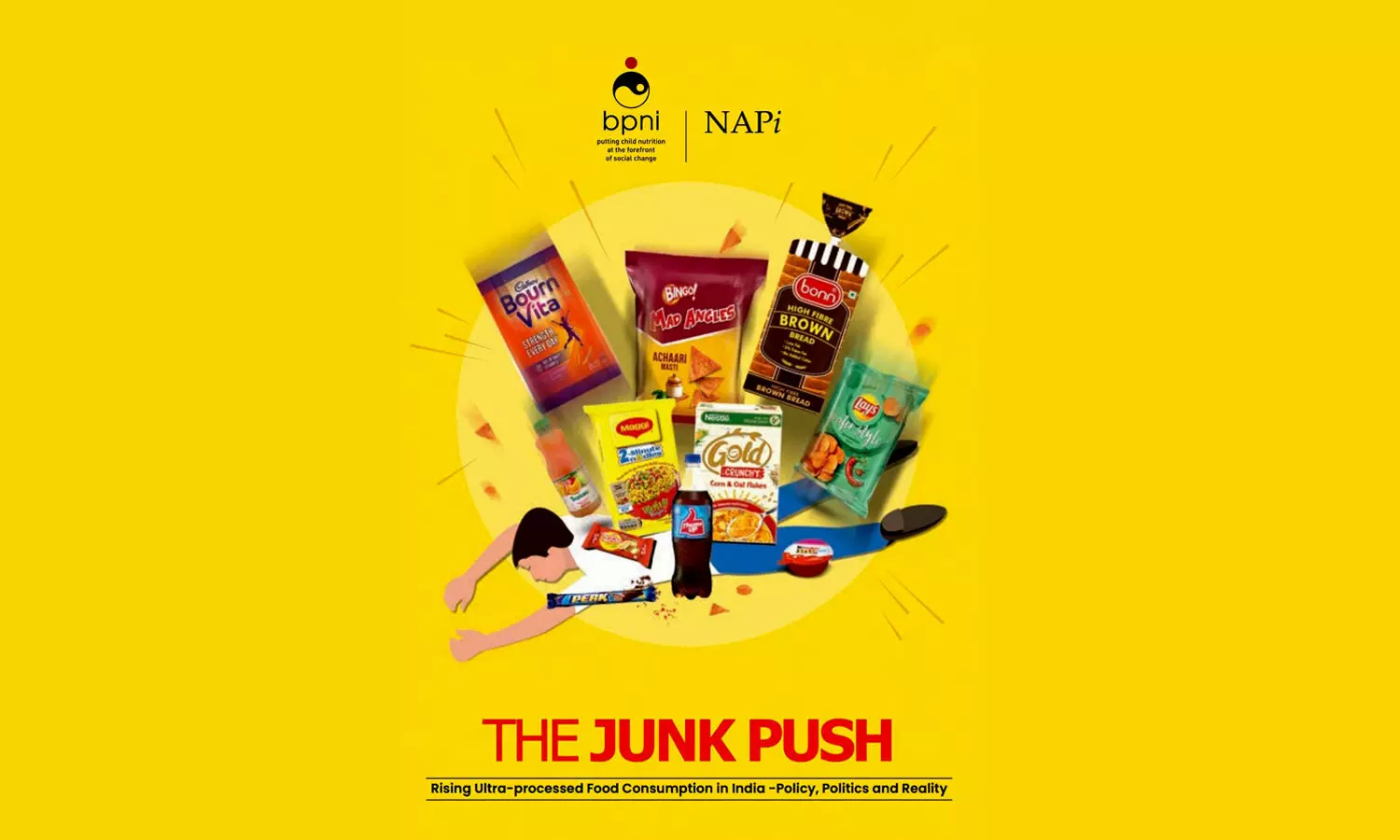Doctors alarmed as 1 in 4 Indians are obese, diabetic due to junk food consumption
Aggressive and pervasive marketing strategies play a substantial role in increasing consumption, says experts

HYDERABAD: India is experiencing a significant increase in obesity and diabetes, with 1 in 4 individuals currently affected.
And one of the key factors contributing to this disease load is increased junk food consumption, which must be decreased, according to a study called Junk Push: Policy, Politics, and Reality of Rising Ultra-processed Food Consumption in India.
The Government of India plans to halt this rise by 2025 which is a significant public health issue, requiring urgent policy measures, according to experts.
The increased intake of junk food and beverages highlights the epidemic of noncommunicable diseases (NCDs), which is now impacting children and vulnerable populations.
According to a recent WHO report, the Ultra-processed Food (UPF) industry in India grew at a compound annual growth rate of 13.37 percent in terms of retail sales value between 2011 and 2021. Additionally, it is projected that Ultra-processed Food would grow faster than staple foods.
According to the survey, the use of junk foods would continue to grow. The retail value of packaged junk food and soft drinks in India grew between 2006 and 2019.
The ultra-processed food sector grew at a compound annual growth rate of 13.37 percent, with projections that the aggregate sales volume of UPFs in middle-income nations would exceed high-income countries by 2024.
According to a survey, the aggregate sales volume of UPFS in middle-income nations would equal that of high-income ones by 2024. Middle-income countries experience higher annual growth in UPF sales than high-income countries.
Surveys from the slums of Delhi found that 11 percent of a family's monthly expenditure is on snacks, and 15 percent of the working members of a household eat outside home. Junk food was also seen as an aspirational choice and shows upward mobility in social status. It was additionally reported that junk food and beverages have made their way into parts of India's urban poor.
A study, that uses panel data from Kantar- World panel Division, India, found that three-quarters of urban Indian households purchased over ten processed food groups between 2013 and 2016: According to a fresh survey in May 2023, the households purchasing beverages, including soft drinks, squashes, powdered mixes and packaged juices, rose from 38 percent in 2019 to 47 percent in 2023. UPF purchases were at 6.4 kg in 2016, but had increased by 6 percent since 2013.
Another study titled 'Intake of ultra-processed foods among adolescents from low-and middle- income families in Delhi' reported that compared to adolescents from low-income homes, adolescents from middle-class families consumed much more energy, fat, carbohydrate, and protein from ultra-processed foods.
A study conducted in urban Indian middle-class found increasing consumption of processed and UPFs Meanwhile, another Kolkata based study conducted on 1026 students showed 70 percent of adolescents aged 14-16 years consume three or more servings of energy-dense snacks the previous day, indicating poor dietary intakes.
Junk food consumption was mainly increasing among school children and people aged less than 30 years. Sugary snacks, salty snacks, and other processed meals are becoming increasingly popular in South India.
A pan India survey revealed that 93% of children consume packed food, 68% consume packaged sweetened beverages more than once a week, and 53% consume these products daily. Nearly 25% of school-going children were found consuming ultra-processed foods, a trend that has been supported by numerous studies.
What are junk foods
In 1972, Michael Jacobson, the director of the Centre for Science in Washington, D.C., introduced the term 'junk food' in public interest. The term 'junk foods' is now widely used to describe unhealthy foods that are high in calories but low in nutritional content.
The World Heart Federation defines an unhealthy diet as one high in sugars, saturated and trans fats, low fiber foods, and high-sugar drinks.
Unhealthy (junk) foods contain little or no proteins, vitamins, or minerals but are high in salt, sugar, fats, and energy (calories), according to the ICMR NIN-Dietary guidelines for Indians.
Some examples are chocolates, artificially flavoured aerated drinks, potato chips, ice creams, French fries etc. More recently, specific definitions of unhealthy foods have emerged based on either the nutrient content, or degree of food processing. These are High in Fat, Salt and Sugar(HFSS) foods or 'UPF'.
Food Safety and Standards Authority of India (FSSAI) draft regulation of September 2022 defines HFSS foods as processed foods high in saturated fat, total sugar, or sodium.
The product's declared ingredients do not meet energy requirements from total sugar, saturated fat, and sodium, containing less than 10 percent of total energy and sodium less than 1 mg/1 kcal.
Unsafe Food is defined by the 'Food Safety and Standards Act, 2006' as: "Unsafe food means an article of food, whose nature, substance or quality is so affected as to render it injurious to health and further as the article being so coloured, flavoured or coated, powdered or polished as to damage or conceal the article so as to make it appear better or of greater value than it really is."
The Nova Classification of Foods
In 2010, Brazilian scientists came up with a new classification for food products based on the degree and intent of processing, and termed it as the 'Nova classification'. Prof. Carlos Monteiro explained the NOVA Food Classification System: rationale, description, and applications, at Columbia University Teachers College on April 6, 2023, Nova classification has four food groups.
Group 1 consists of unprocessed or minimally processed foods such as fruits, vegetables, pulses, rice, eggs, meat, fish, or milk.
Group 2 consists of processed culinary ingredients, including salt, vegetable oils, butter, sugar, and other substances used to prepare meals.
Group 3 is 'processed foods, which consist of canned vegetables or fruits with added salt or sugar.
Group 4 consists of ultra-processed foods (UPFS) such as chips, cookies, sweets, soft beverages, hot dogs, instant noodles, sugary cereals, frozen meals, ice cream, bakery items, and chocolates. UPFS undergoes numerous industrial processes, and are chemically or physically transformed, by destroying the food matrix.
UPFS contains colouring and flavoring agents, cosmetic additives, stabilizers, emulsifiers, and other components not typically found in domestic kitchens, making them highly palatable and addictive.
UPFS, high in sugars, saturated fat, and salt/sodium, are pre-packaged, low in nutritional quality, and high in energy density, displacing real foods with palatability and affordability.
What makes junk food harmful
A study in India found that junk foods significantly contribute to children's daily intake of carbohydrates, free sugars, total fats, saturated fat, and sodium through an addictive mechanism. Junk food is linked to negative health outcomes, regardless of its nutrient content.
A PREDIMED-Plus cohort study found that high energy density, added sugars, salt, and saturated/trans fatty acids consumption of UPF is linked to lower Mediterranean Diet adherence, increased energy intake, and inflammatory gastro-intestinal diseases.
The consumption of UPFS disrupts the trillions of gut microbes that play crucial roles in human health, including digestion, metabolism, and immune mechanisms.
Food can be potentially toxic during packaging, particularly when exposed to long periods of exposure.
Impact of junk food on public health
The Indian government acknowledges the detrimental effects of junk food consumption and its role in increasing non-communicable diseases (NCDs).
In 2022, the Minister of State of Health and Family Welfare responded to a Parliamentary question, "Regular consumption of ultra-processed High Fat Sugar and Sodium (HFSS) foods has adverse effects on the health of individuals. Review of scientific literature suggests a strong association between higher consumption of processed foods high in fat sugar and sodium with obesity markers such as greater Body Mass Index (BMI) and waist circumference and many non-communicable diseases (NCDs)".
Over the past decade, numerous scientific studies have linked junk food to an increasing number of chronic diseases. Ultra-processing disrupts the food matrix, compromising nutrition quality and affecting satiety, leading to increased consumption.
The excessive consumption of ultra-processed diets has been linked to an increased risk of obesity. Ultra Processed foods(UPFs) are increasing the risk of type 2 diabetes, heart disease, stroke, depression, and premature death, with every 10 percent increase in consumption linked to a 15 percent higher risk.
New research indicates that UPF consumption can accelerate cognitive decline, contribute to dementia, anxiety, and depression, and may also increase the risk of dementia.
Another study found that higher UPF consumption in T2DM patients leads to reduced survival and higher CVD mortality rates, regardless of diet quality.
Aggressive, pervasive marketing strategies play substantial role in increasing junk food consumption
The study 'Junk Push: Policy, Politics, and Reality of Rising Ultra-processed Food Consumption' highlighted the significant role of aggressive marketing strategies in increasing consumption of junk food.
According to Convenor Nutrition Advocacy in Public Interest (NAPi) and Senior Paediatrician Dr. Arun Gupta, one of the authors of the Junk Push study, more than 200,000 junk food advertisements were flashed per month.
Studies in India revealed harmful food marketing targeting children, using celebrities, health claims, and emotionally strong messages to gain parental influence and approval through emotionally strong messages.
The National Multisectoral Action Plan(NMAP) (2017-2022) outputs propose legal frameworks for advertising restrictions, interpretive Front of Package Labeling(FOPL) and higher taxation on junk foods, supported by WHO, presenting India with an opportunity. However, India's strong reliance on self-regulation makes it difficult to adopt regulatory policy in these areas, says experts.
The study proposes 10 recommendations, supported by strong evidence, as a public health priority, aiming to be implemented without any other considerations.
The study's findings would aid India's government in addressing policy gaps, promoting prevention of NCDs, and achieving its goal of reducing obesity and diabetes by 2030, if not 2025.
Ten recommendations by the experts to curb junk food in India
- Food companies, their front organisations, or individuals supported by them should not be part of the decision-making process to develop a policy to reduce exposure to harmful marketing and consumption of UPFS or other junk foods. Article 5.3 of the WHO Framework Convention on Tobacco Control (FCTC) prevents tobacco companies from contributing to health policy. Similar guidelines should be developed and applied to eliminate the influence of the food industry on policymaking.
- The Union Ministry of Health & Family Welfare (MoHFW)may urgently establish the thresholds of nutrients of concern, i.e., sugars, salt, and saturated fat, in pre-packaged foods. This would be of immediate help to identify which foods can be advertised, have a warning FOPL, or deserve higher taxes. The HFSS definition in the FSSAI Draft Regulation (September 2022) may be a good start.
- The FSSAI under the MOHFW, as a follow-up action of the NMAP, may urgently adopt an interpretive FOPL (warning label) for all junk foods (HFSS or UPFs).
- The MoHFW and/or the Ministry of Information and Broadcasting may frame a 'Bill' on 'Prevention of NCDs to Halt the Rise of Diabetes and Obesity in India' with the objectives to define healthy foods and junk foods (UPF, HFSS) and impose reasonable restrictions on the marketing and advertising of junk foods, especially to children up to 18 years. Reasonable restrictions could include every medium, sponsorship in schools, gifts for students, etc. Television advertisements for junk food may be prohibited from 6 a.m. to 10 p.m. Further, the MolB may also amend the Cable Television Networks Regulation (Amendment) Act 2000. Rule 7(2)(viii), to include a ban on advertisements that directly or indirectly promote HFSS/ junk foods, similar to the existing ban on advertisements for infant foods.
- The MoHFW, Ministries of Education, Sports, and Home Affairs, may direct schools, hospitals, prisons, and other public service offices and areas not to serve UPFS and other junk foods.
- The GST council may consider the highest GST slab for UPFS and other junk foods, similar to a sin-tax for cola drinks.
- The Ministry of Food and Civil Supplies and Food Processing, Government of India, should consider making real food affordable and accessible through incentives to produce 'healthy foods', and making sure that the junk food industry is not incentivised.
- The Ministry of Consumer Affairs may consider an amendment to CCPA guidelines 2022 to prevent misleading advertisements by removing provisions in Section 8(i) and Section
- Further, a clear interpretation of what the most important information about food products is would be helpful. A suggested definition may be included for quick decision-making on misleading advertisements.
- OnCivil society organisations, consumer groups, human rights groups, professional and academic groups in public health, academicians, and others concerned should be encouraged to join hands with the government to form a 'strong coalition' to work together and find ways and means to educate children and adults on the harms of UPFs and other junk foods and to combat the food industry's objective of derailing policy. However, such organisations and the Coalition must not have any conflicts of interest.
(Inputs from Junk Push: Policy, Politics, and Reality of Rising Ultra-processed Food Consumption: Authors: Dr. Arun Gupta, MD, FIAP, is a pediatrician and Convener, NAPi, Nupur Bidla, MSW, is a member of NAPi and Reema Dutta, MPH, are members of NAPi)



